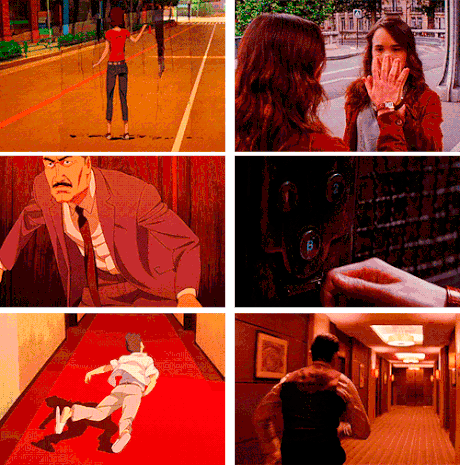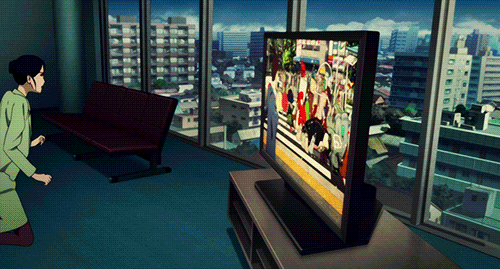
Satoshi Kon, perhaps best known for his films Perfect Blue and Tokyo Godfathers, returns for his fourth and final film in this beautifully-animated psychological thriller. Written by both Kon and Seishi Minakami, who worked on Kon’s Paranoia Agent, Paprika was adapted from the 1993 book of the same name, in which a clinic conducts dream therapy to help treat mental disorders.
Dr. Atsuho Chiba and her team, Dr. Torataro Shima and Dr. Kosaku Tokita, work at a psychiatric clinic helping patients undergoing trauma. However, she also illegally uses a new and prototypical form of technology–the DC Mini–to conduct dream therapy as her alter ego: a young, red-haired girl named Paprika. One client, Detective Toshimi Konakawa, is plagued by a recurring dream of the death of his partner. As the mystery of his dream unfolds, Dr. Chiba and her team notice that the DC Mini has somehow been hacked and soon they all become engulfed in the dream world, where what they do in the dream world can affect them in the real world.

Similar to Satoshi Kon’s Perfect Blue, Paprika messes with your head, making you constantly ask what is real and what’s a dream. However, while most of the scenes in Perfect Blue are rather disturbing, Paprika has a largely light-hearted look to it, with bright, bold colors and whimsical music. This is on full display when we see the parade sequences in Dr. Shima’s dreams, which feature various puppets, anthropomorphic frogs and other animals, and even major monuments such as The Statue of Liberty. However, the feeling you get from the scene is not one of comfort or happiness. It’s a rather unsettling and even foreboding feeling of unease.

Kon stated that Paprika explores the fine line between fiction and reality. According to Satoshi Kon, both fiction and reality are not separate, but the same. Paprika was to explore the distorted reality that exists in our dreams that mirrors our waking lives. An example of this is the duality of Dr. Chiba and Paprika. While both are the same person, they behave drastically different. Paprika is playful, mysterious, and fully in tune with the emotions of others. Dr. Chiba, on the other hand, is serious, goal oriented, and keeps her deepest emotions hidden to the point of denial.

Despite the symbolism of the film and the message that Satoshi Kon tried to convey, I felt largely confused by not just the plot, but mostly by the motivations of the main antagonist, Chairman Dr. Seijuro Inui. I never understood why he wanted to rule over the dream world. He does have a smaller motivation of wanting to walk again by taking a younger body, but this really isn’t focused on much being verbally mentioned…once I think? Also, the DC Mini isn’t ever stated to be able to do this.


I’d like to also add that this film feels a lot like Christopher Nolan’s Inception (2010). Both movies explore the dream world and contain very trippy and distorted dream realities, blurring the lines between dreams and reality. Additionally, both have various scenes that are quite similar to each other, and have story elements focusing on helping people emotionally through dreams. Hell, Inception has a fan interpretation that it is a metaphor for making films while in Paprika, film is an important element for one character and his issues.

However, the two films are very different in many ways, the main difference between the two being how the themes are done. Inception is a heist film involving characters trying to plant a thought into someone’s head, resulting in the characters making the dreams like one would make a movie. The emotional help that is reached is done mostly by accident with one having his personal issues overcome due to them literally messing up the plans, and the other one being helped is their target with their plan just happening to give their target closure. Meanwhile, Paprika is a thriller where dreams threaten to take over reality. The emotional help given to the Detective is done in good faith, with no ulterior motivations involved.

One of the most important (and noticeable) differences is the visuals of the dreams. Inception has a lot of nonsensical environments and structures, but Paprika takes it up to eleven. Paprika herself transitions from riding a bike to being in an image on a truck, to then leave the image and fly in the sky, followed by being on a billboard. And all of that is in the opening credits and not even everything in those credits.
In general, Paprika takes advantage of its animation, which allows it to have much more wild images than Inception could ever get away with. In Inception, a city folds, a room rotates in an impressive effect, and a few seconds in one dream could be hours in another. In Paprika, characters fly on clouds, grow to an enormous size, push their way into another room like they are breaking through an elastic wall, and soon after, being inside a film screen. A lot of times, characters are less human in appearance instead looking like objects, and the climax…just speaks for itself. The difference between the two in visuals is that Inception is, ironically, more grounded in reality than Paprika.

While Paprika might not be as groundbreaking or emotional as Satoshi Kon’s other films, such as Perfect Blue or Tokyo Godfathers, it is still a visually-sound film that blurs the line of reality and fiction. Despite being confusing at times, Paprika nonetheless keeps you invested through its spectacular aesthetics and animation as it plunges you headfirst into a bizarre adventure.

Co-Written by: Owen Gonzalez